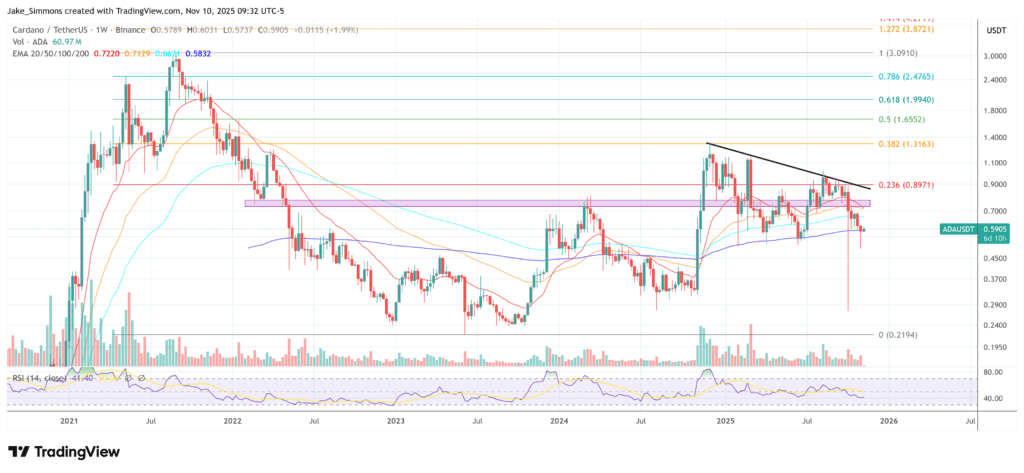
Broadcast on November 11 from “hot and sunny Colorado,” Cardano founder Charles Hoskinson said he expects RealFi to become the dominant liquidity engine on the Cardano-Midnight stack and push on-chain value to the $1 billion mark over the next year. “RealFi will be the monster TVL for Cardano and Midnight. Billions and billions of dollars,” he said, adding a concrete goal: “I want a TVL of over a billion dollars by the end of 2026.”
How Hoskinson wants to reach a billion-dollar Cardano TVL
The pledge situates RealFi – Cardano’s long-running effort in micro-lending and real-world credit rails – as the centerpiece of a broader liquidity plan that covers Bitcoin inflows, midnight privacy-preserving DeFi, and trustless cross-chain settlement.
Hoskinson described Midnight as a fourth-generation crypto platform designed for “rational privacy, selective disclosure, and cooperative economics,” positioning it as an everyone-neutral L2 that routes identity, compliance, and privacy logic off-chain while settling into the networks holding users and liquidity. “Minuit’s dream is to be layer 2 for everyone. You can deploy in Ethereum, you can deploy in Solana, you can deploy in Cardano,” he said.
He directly linked this architecture to the demand for ADA and the economics of stake pools. “Midnight exists as a smart contract on Cardano (…) If Midnight is heavily used, that creates ADA usage,” Hoskinson said. Fees may be abstract, but “there has to be ADA at the end of the rainbow,” with Midnight staking paying Knight token to SPOs on Cardano so that “you do ADA and Knight.” He argued that this design increases the transaction load on Cardano, expands Cardano’s native asset lists, and opens “new revenue streams for stake pool operators.”
Regarding interoperability, Hoskinson said the final stage of Midnight’s deployment includes a two-way recursive SNARK bridge with Cardano that removes traditional bridge operators. “On the Cardano side, we have added BLS support (…) both sides will have trustless bridging capability.”
He coupled this with performance claims – “5,000 TPS and sub-second block time” for the proof aggregation role – and rapid settlement once Ouroboros Peras lands, describing Midnight as a proof engine and coordination layer capable of bending the state of connected chains and returning constant-size proofs “validated on a mobile phone”.
The liquidity plan extends to Bitcoin and RealFi. Regarding Bitcoin DeFi, Hoskinson said the team was “able to secure over 24,000 BTC” that could be moved, while recognizing that control elements are yield products and finalizing the technology stack. His comments on RealFi were unequivocal: the initiative “is going to be a huge (comprehensive) thing next year,” with smart contracts “being written right now,” and he reiterated the thesis that peer-to-peer microlending in Africa, South America, and Southeast Asia can anchor on-chain credit flows. “Billions and billions of dollars,” he said.
Midnight’s go-to-market cadence is built around privacy-first DeFi and cross-chain composability. Hoskinson wants privacy-friendly stablecoins and DEXs at midnight and has been explicit about his distaste for centralized, asset-backed stablecoins: “They can be frozen at any time (…) It’s not a cryptocurrency. » He highlighted private algorithmic designs as the preferred route and said oracles and bridges will arrive via decentralized integrations rather than bespoke native rewrites. “When Chainlink? (…) We can simply use a trustless bridge, proofs and reliable execution environments to pass information.”
He also highlighted early traction metrics and community programs designed to accelerate adoption. During the midnight treasure hunt, he claimed “that in 21 days, more calculations have been spent (…) than the first years of Bitcoin”, with detailed figures promised at the next midnight summit near London. For ecosystem growth, it plans to recruit and pay 500 Midnight Ambassadors in 2026, channeling a portion of their compensation to Midnight DeFi and targeting “hundreds of thousands of monthly active users” and significant cross-chain transaction flow.
The AMA presented an in-depth critique of the Cardano Foundation’s governance and incentive structure, which it said has hindered critical integrations such as stablecoins. “This is bad structure, bad governance, bad leadership,” he said, calling for a community-elected board and the publication of key performance indicators. He compared it to what he called “tough love” for a maturation protocol: “Cardano has grown up. He has to go to college (…) You never abandon your children. You just fundamentally change your relationship.”
At press time, ADA was trading at $0.59.

Featured image created with DALL.E, chart from TradingView.com

Editorial process as Bitcoinist focuses on providing thoroughly researched, accurate and unbiased content. We follow strict sourcing standards and every page undergoes careful review by our team of top technology experts and seasoned editors. This process ensures the integrity, relevance and value of our content to our readers.




